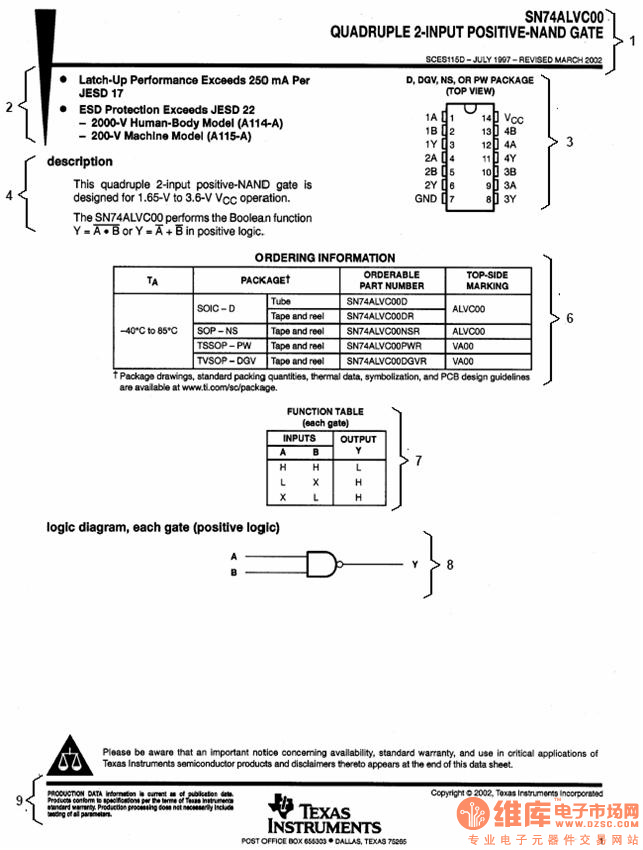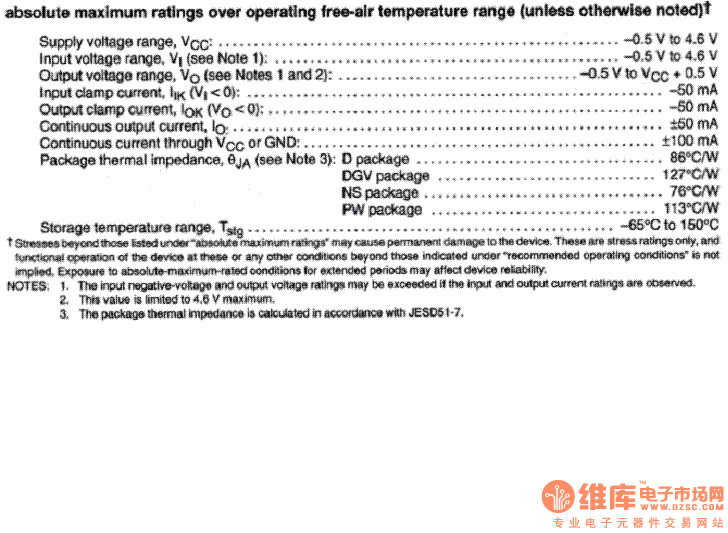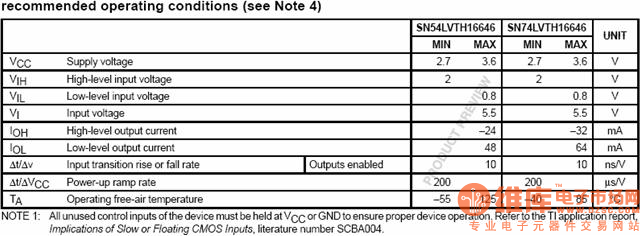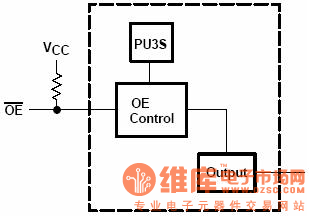|
|||||||||||
| 技术交流 | 电路欣赏 | 工控天地 | 数字广电 | 通信技术 | 电源技术 | 测控之家 | EMC技术 | ARM技术 | EDA技术 | PCB技术 | 嵌入式系统 驱动编程 | 集成电路 | 器件替换 | 模拟技术 | 新手园地 | 单 片 机 | DSP技术 | MCU技术 | IC 设计 | IC 产业 | CAN-bus/DeviceNe |
研讨翻译:TI标准逻辑数据手册术语符号的解释与理解 |
||||
| 作者:kasami 栏目:模拟技术 | ||||
这篇文章对阅读资料很用参考价值,请关注。
原著:Stephen M. Nolan and JOSE M. Soltero 翻译:kasami ABSTRACT 摘要
说明:根据一位网友的建议,现试着以学习的态度来翻译这篇文章,请大家多加点评,多多指教。需要大家谅解的是,因没有保存链接,需要原文,请到TI网站查找,也诚望先找到的朋友跟帖提供链接,学生在此先谢过大家了!! * - 本贴最后修改时间:2005-4-24 0:41:35 修改者:IC921 |
| 2楼: | >>参与讨论 |
| 作者: IC921 于 2005/4/13 22:38:00 发布:
kasami同学大胆翻译,请大家大力支持!! kasami同学大胆翻译,请大家大力支持!! |
|
| 3楼: | >>参与讨论 | |||||||||||||||||||||||||||||||||||||||||||||||||||||||||||||||||||||||||||
| 作者: IC921 于 2005/4/13 22:45:00 发布:
附图链接和文章推荐
* - 本贴最后修改时间:2005-4-24 21:57:53 修改者:IC921 |
||||||||||||||||||||||||||||||||||||||||||||||||||||||||||||||||||||||||||||
| 4楼: | >>参与讨论 |
| 作者: akaer 于 2005/4/13 22:52:00 发布:
Thanks, kasami! 感觉你的译文质量不错,与原文挺贴的。另外你第一次参加研讨翻译活动就能做到如此规范,实在难得! 这一段中,有一个地方和你探讨:electrical specifications,我觉得翻译成“电气指标”更好些。 期待你后面的作品! * - 本贴最后修改时间:2005-4-13 23:01:02 修改者:akaer |
|
| 5楼: | >>参与讨论 |
| 作者: IC921 于 2005/4/13 23:07:00 发布:
文件目录(仅作为分节之参考) 附图列表 2 ABSTRACT 摘要 3 正文目录 4 1 Introduction 导言 7 2 Top-Level Look at the TI LOGIC Data Sheet 7 2.1 Summary DEVICE DESCRIPTION 8 2.2 Absolute Maximum Ratings 10 2.3 Recommended Operating Conditions 推荐工作条件 11 2.4 Electrical Characteristics 13 2.5 Live-Insertion Specifications 14 2.6 Timing Requirements 15 2.7 Switching Characteristics 16 2.8 Noise Characteristics 17 2.9 Operating Characteristics 17 2.10 Parameter Measurement Information 18 3 Dissecting the TI LOGIC Data Sheet 19 3.1 Summary DEVICE DESCRIPTION 20 3.1.1 Title, Literature NUMBER, and Dates of Origination and Revision 20 3.1.1.1 Example: 20 3.1.1.2 Level-Shifting DIODE (D) 24 3.1.1.3 Bus-Hold (H) 25 3.1.1.4 Damping RESISTOR on Inputs/OUTPUTs (R) 26 3.1.1.5 Schottky Clamping DIODE (S) 26 3.1.1.6 Undershoot-Protection Circuitry (K) 27 3.1.1.7 Power-Up 3-State (Z) 28 3.1.2 Features Bullets 29 3.1.3 PACKAGE Options and Pinouts 30 3.1.4 DESCRIPTION 31 3.1.5 BGA Packaging Top-View Illustrations and Pin-Assignments Table 31 3.1.6 Ordering Information 31 3.1.7 Function Table 33 3.1.8 LOGIC Diagram 36 3.1.9 PRODUCT Development Stage Note 37 3.2 Absolute Maximum Ratings 38 3.2.1 Supply Voltage, VCC 38 3.2.2 Input Voltage, VI 38 3.2.3 OUTPUT Voltage, VO 39 3.2.4 Voltage Range Applied to Any OUTPUT in the High-Impedance or Power-Off State, VO 40 3.2.5 Voltage Range Applied to Any OUTPUT in the High State, VO 41 3.2.6 Input Clamp Current, IIK 41 3.2.7 OUTPUT Clamp Current, IOK 42 3.2.8 Continuous OUTPUT Current, IO 42 3.2.9 Continuous Current Through VCC or GND Terminals 42 3.2.10 PACKAGE THERMAL Impedance, Junction-to-Ambient, θJA 42 3.2.11 Storage Temperature Range, Tstg 43 3.3 Recommended Operating Conditions 推荐工作条件 43 3.3.1 VCC Supply Voltage 43 3.3.2 BIAS VCC Bias Supply Voltage 44 3.3.3 VTT Termination Voltage 44 3.3.4 Vref Reference Voltage 45 3.3.5 VIH High-Level Input Voltage 45 3.3.6 VIL Low-level Input Voltage 47 3.3.7 IOH High-Level OUTPUT Current 49 3.3.8 IOHS Static High-Level OUTPUT Current 49 3.3.9 IOL Low-Level OUTPUT Current 50 3.3.10 IOLS Static Low-Level OUTPUT Current 51 3.3.11 VI Input Voltage 52 3.3.12 VO OUTPUT Voltage 53 3.3.13 Δt /Δv Input Transition Rise or Fall Rate 54 3.3.14 Δt /ΔVCC Power-up Ramp Rate 55 3.3.15 TA Operating Free-Air Temperature 55 3.4 Electrical Characteristics 59 3.4.1 VT+ Positive-Going Input Threshold Level 59 3.4.2 VT– Negative-Going Input Threshold Level 60 3.4.3 ΔVT Hysteresis (VT+ – VT–) 60 3.4.4 VIK Input Clamp Voltage 63 3.4.5 VOH High-Level OUTPUT Voltage 63 3.4.6 VOHS Static High-level OUTPUT Voltage 64 3.4.7 VOL Low-Level OUTPUT Voltage 65 3.4.8 VOLS Static Low-Level OUTPUT Voltage 65 3.4.9 ron On-State Resistance 66 3.4.10 II Input Current 66 3.4.11 IIH High-Level Input Current 67 3.4.12 IIL Low-Level Input Current 68 3.4.13 II(hold) Input Hold Current 68 3.4.13 IBHH Bus-Hold High Sustaining Current 70 3.4.14 IBHL Bus-Hold Low Sustaining Current 71 3.4.15 IBHHO Bus-Hold High Overdrive Current 71 3.4.16 IBHLO Bus-Hold Low Overdrive Current 71 3.4.17 Ioff Input/OUTPUT Power-Off Leakage Current 72 3.4.18 IOZ Off-State (High-Impedance State) OUTPUT Current (of a 3-State OUTPUT) 74 3.4.19 IOZH Off-State OUTPUT Current With High-Level Voltage Applied 75 3.4.20 IOZL Off-State OUTPUT Current With Low-Level Voltage Applied 76 3.4.21 IOZPD Power-Down Off-State (High-Impedance State) OUTPUT Current (of a 3-State OUTPUT) 77 3.4.22 IOZPU Power-Up Off-State (High-Impedance State) OUTPUT Current (of a 3-State OUTPUT) 79 3.4.23 ICEX OUTPUT High Leakage Current 79 3.4.24 ICC Supply Current 80 3.4.25 ΔICC Supply-Current Change 80 3.4.26 Ci Input Capacitance 81 3.4.27 Cio Input/OUTPUT Capacitance 82 3.4.29 Co OUTPUT Capacitance 83 3.5 Live-Insertion Specifications 83 3.5.1 ICC (BIAS VCC) BIAS VCC Current 83 3.5.2 VO OUTPUT Bias Voltage 84 3.5.3 IO OUTPUT Bias Current 84 3.6 Timing Requirements 84 3.6.1 fclock Clock Frequency 84 3.6.2 tw PULSE Duration (Width) 85 3.6.3 tsu Setup Time 86 3.6.4 th Hold Time 87 3.7 Switching Characteristics 89 3.7.1 fmax Maximum Clock Frequency 89 3.7.2 tpd Propagation Delay Time 90 3.7.3 tPHL Propagation Delay Time, High-Level to Low-Level OUTPUT 91 3.7.4 tPLH Propagation Delay Time, Low-Level to High-Level OUTPUT 92 3.7.5 ten Enable Time (of a 3-State or Open-Collector OUTPUT) 93 3.7.6 tPZH Enable Time (of a 3-State OUTPUT) to High Level 93 3.7.8 tPZL Enable Time (of a 3-State OUTPUT) to Low Level 94 3.7.9 tdis Disable Time (of a 3-State or Open-Collector OUTPUT) 95 3.7.10 tPHZ Disable Time (of a 3-State OUTPUT) From High Level 95 3.7.11 tPLZ Disable Time (of a 3-State OUTPUT) From Low Level 96 3.7.12 tf Fall Time 96 3.7.13 tr Rise Time 96 3.7.14 Slew Rate 97 3.7.15 tsk(i) Input Skew 97 3.7.16 tsk(l) Limit Skew 97 3.7.17 tsk(o) OUTPUT Skew 98 3.7.18 tsk(p) PULSE Skew 98 3.7.19 tsk(pr) PROCESS Skew 99 3.8 Noise Characterist |
|
| 6楼: | >>参与讨论 | ||||||||||||
| 作者: kasami 于 2005/4/13 23:48:00 发布:
TI技术文章翻译:标准逻辑数据手册术语符号的解释与理解 (2) Introduction 导言
Top-Level Look at the TI LOGIC Data Sheet
* - 本贴最后修改时间:2005-4-15 0:13:02 修改者:IC921 |
|||||||||||||
| 7楼: | >>参与讨论 |
| 作者: IC921 于 2005/4/14 1:41:00 发布:
[003]2.Top-Level Look at the TI Data Sheet “纵观”一词建议改为“概貌”。 同一句:component parts of a data sheet 作“数据手册的组成部分”更好。 [002]等处的component一词,感觉不好,但一时找不到合适的词来表达。 |
|
| 8楼: | >>参与讨论 |
| 作者: kenand 于 2005/4/14 8:24:00 发布:
to kasami abstrct ................ abstract................ 我相信这是你的笔误, |
|
| 9楼: | >>参与讨论 |
| 作者: kasami 于 2005/4/14 11:35:00 发布:
见笑了,的确是笔误 |
|
| 10楼: | >>参与讨论 |
| 作者: kasami 于 2005/4/14 11:37:00 发布:
谢谢,我会继续努力的,多给意见啊 |
|
| 11楼: | >>参与讨论 |
| 作者: kasami 于 2005/4/14 11:44:00 发布:
多谢各位 感谢各位的宝贵意见,本人第一次翻译,有不足之处,请多多指教,谢谢! |
|
| 12楼: | >>参与讨论 |
| 作者: kasami 于 2005/4/14 11:49:00 发布:
electrical specifications “电气指标”更好 |
|
| 13楼: | >>参与讨论 |
| 作者: kasami 于 2005/4/14 12:05:00 发布:
我怎么就想不到呢? Top-Level Look 翻译成“概貌” ,真是太贴切了,我怎么就想不到呢?佩服 |
|
| 14楼: | >>参与讨论 |
| 作者: 宇宙飞船 于 2005/4/14 15:16:00 发布:
organized into five main sections这句话的译法有出入? This application report is organized into five main sections: 这份应用报告包括以下五个部分: //------------------------------------------- 这句话如果译成:这应用报告由主要的五个部份组成。 就能更符合原来的意思。 organized into 有由。。。。。。构成意思 main sections 其中的main 是修饰 five section.所以要把形容词修饰部分的意思也准确译出来才能是上上之作。 |
|
| 15楼: | >>参与讨论 |
| 作者: zhousd 于 2005/4/14 16:40:00 发布:
very GOOD! |
|
| 16楼: | >>参与讨论 |
| 作者: kasami 于 2005/4/14 16:41:00 发布:
为什么不译成:这份应用报告由五个主要部分组成 “This application report is organized into five main sections:”译成“这份应用报告由五个主要部分组成:”岂不是更符合原文意思? |
|
| 17楼: | >>参与讨论 |
| 作者: zhousd 于 2005/4/14 16:52:00 发布:
这才叫水平,宇宙飞船果然是真人 不出手则已,一但出手,句句分析入木三分,这才叫E文水平。 我说楼上的kasami 是想同TI 做广告吧?看你的翻释贴子没有一点实力,这样的水平还好意思在此摆。 什么叫做E 文水平你知道吗?好的翻译文章就是一本现成的语法教材! 宇宙飞船改正过来后的那句就叫水平!真正的前辈高人也。 * - 本贴最后修改时间:2005-4-14 17:01:48 修改者:zhousd |
|
| 18楼: | >>参与讨论 |
| 作者: akaer 于 2005/4/14 18:53:00 发布:
与zhousd的几句题外话 网友的评论,不论是批评还是鼓励,只要亮出观点,作为研讨翻译活动的参与者,相信都会认为是对自己努力劳动的良好反馈。 不过,我觉得这里首先是一个技术论坛,kasami、我以及很多参与者都是在学习、共享技术的前提下,用这种方式锻炼英文能力。因此,我以为在信、达、雅的总要求下,是不是可以稍微放松一下,“保信、争达、望雅”可能更务实些,你说呢?:) |
|
| 19楼: | >>参与讨论 |
| 作者: IC921 于 2005/4/14 19:20:00 发布:
to zhousd:谢谢你来加油,但要注意一点原则 看得出你非常会给飞船加油哪! 但我想说明的一点是,kasami还是学生,译这篇文章原本是采取我的建议的结果,不要误会了。严格一点地说,做TI广告我也不够格,更何况撇开TI广告的话不说,连TI的文章也不能译,开这个论坛,也就没有什么意思了。kasami同学敢于出来到这里检验和磨练自己,精神非常可可嘉,要鼓励,多指导。不要对付出劳动的译者水平做不适当的评论或责难,以免伤害及其本人乃至他人的积极性。这点原则应当掌握好。 这篇文章非常基础,能全面了解,不仅对阅读资料非常有帮助,而且能让其本人乃至更多人对国际化大公司的规范性有所感受,这是这篇文章难得的地方之一。 文章实质内容还在后面,请你多多地从技术层面上加以支持。我想,如果你能译更多TI、ADI等国外大牌的文章,不但是给飞船加油,还会得到更多的欢迎。 |
|
| 20楼: | >>参与讨论 |
| 作者: kasami 于 2005/4/14 19:43:00 发布:
thanks ,akaer and IC921 |
|
| 21楼: | >>参与讨论 |
| 作者: asunmad 于 2005/4/14 21:02:00 发布:
支持一下,顺带点评一下。 如果翻译具体某个产品的DATA SHEET还有广告之嫌的话,翻译这种概述性的材料应该说是一种值得提倡的行为。其实里面所讲的内容不往往不只是适用于某一家公司的产品,弄清楚基本概念对阅读任何一家公司同类产品的DATA SHEET都是有帮助的。 这开头几段翻译得不错,值得学习。但拍马的话少说,还是以研讨表示支持吧~~~ [002] To assist component and system-design engineers in selecting Texas Instruments (TI) standard-logic products, this application report is a synopsis of the information available from a typical TI data sheet. 为帮助组件和系统设计工程师选择TI标准逻辑产品,这份应用报告是来自于典型TI数据册的有用信息的摘要。 意思明确,但读起来略感别扭。该句开头的To=In order to,引导的状语从句可放一主句前面,也可以放到主句后面。我感觉译文如放到后面读起来会略微舒服些。但主句的翻译想来想去还是译不好,试译如下: 这份应用报告是对典型的TI数据手册中所提供的信息的一个摘要,目的是为了帮助组件设计工程师和系统设计工程师选择TI的标准逻辑产品。 Symbols, terms, and definitions generally are in accordance with those currently agreed upon by the JEDEC Solid State TECHNOLOGY Association for use in the USA and by the International Electrotechnical Commission (IEC) for international use. 符号、术语和定义一般与JEDEC和IEC现在允许的协议有关。 in accordance with是与……一致的意思,不是“有关”。试译: (本文中)符号、术语、定义一般与JEDEC固态技术协会认可在美国国内使用的符号、术语、定义以及国际电工委员会(IEC)认可在国际上使用的符号、术语、定义是一致的。 感觉我的译文有点冗长,希望有人帮我减减肥:) * - 本贴最后修改时间:2005-4-14 21:06:02 修改者:asunmad |
|
| 22楼: | >>参与讨论 |
| 作者: 宇宙飞船 于 2005/4/14 22:45:00 发布:
to zhousd 老哥您的语气能平和一点就好 翻译一篇长的专业技术文章不容易,要负出很大的努力和精力,能做到每句都翻译得很准确是很难的事,kasami 译出来的质量已经很不错了,我自问还没法达到他这个水平,可能是您的水平很高吧,但也不能用这样的心态对待别人。我们应该为他打气,鼓励才对,万万不可用这样的口气。 坛子新开张,需要大家好的建议和参与,希望大家能抛开一切顾虑,敞开胸怀。 * - 本贴最后修改时间:2005-4-14 23:08:41 修改者:宇宙飞船 |
|
| 23楼: | >>参与讨论 | ||||||||
| 作者: kasami 于 2005/4/14 23:51:00 发布:
TI技术文章翻译:标准逻辑数据手册术语符号的解释与理解(3) Summary DEVICE DESCRIPTION Figure 1. Example of Summary DEVICE DESCRIPTION
* - 本贴最后修改时间:2005-4-15 0:24:58 修改者:IC921 |
|||||||||
| 24楼: | >>参与讨论 |
| 作者: kasami 于 2005/4/15 13:04:00 发布:
Live-insertion我不知道怎么翻译 Live-insertion我不知道怎么翻译,但是我觉得这个可能和计算机中的即插即用类似,所以这么翻译了,哪位高手指点一下 |
|
| 25楼: | >>参与讨论 |
| 作者: kasami 于 2005/4/15 13:23:00 发布:
谢谢IC921 真的谢谢版主IC921对我的帮助,我翻译那篇文章也是根据他的建议!我是研一的学生,以前对自己的英语水平还是蛮自信的,但翻译起来才发现自己just so-so,虽然有点难度,但我还是决定坚持下去,继续翻译!翻译水平有限,恳请各位多多指教! |
|
| 26楼: | >>参与讨论 |
| 作者: zhousd 于 2005/4/15 14:07:00 发布:
Live-insertion 直译过来就是:热插入,带电插入 的意思 也就是USB中的:即插即用 这点您译得没有错呀 * - 本贴最后修改时间:2005-4-15 14:09:53 修改者:zhousd |
|
| 27楼: | >>参与讨论 |
| 作者: akaer 于 2005/4/15 18:29:00 发布:
Reply in English, maybe Chiglish, haha [005] STRESS levels: Obviously, voltage ratings is just a PART of the "absolute maximum ratings" section, so I think "耐压等级" is not suitable here. Maybe "极端使用条件" is better. The sentence "器件的实际工作在这种条件或在其它任何条件下超过推荐操作条件是不可取的" is a little complicated to me, though no grammar problem founded in it. I think "functional operation" here means "work as designed, but performance not guaranteed". [006] observed: I think it can be ignored in target sentence since you had used a "条件状语". BTW, if you add a "当" in it, it'll better I think. |
|
| 28楼: | >>参与讨论 |
| 作者: asunmad 于 2005/4/15 21:21:00 发布:
Comments on [005] [005] However, these are STRESS ratings ONLY, and functional operation of the DEVICE at these or any other conditions beyond those indicated under recommended operating conditions is not implied. 然而,这些只是应力等级,并不意味着在这些应力下或者任何其它超过“推荐工作条件”所指定的条件下器件的功能正确。 |
|
| 29楼: | >>参与讨论 | ||||||||
| 作者: kasami 于 2005/4/16 1:46:00 发布:
TI技术文章翻译:标准逻辑数据手册术语符号的解释与理解(4) Absolute Maximum Ratings绝对最大额定值
 Figure 2. Example of Absolute Maximum Ratings Section 图2:绝对最大额定值一节的示例 * - 本贴最后修改时间:2005-4-24 0:47:48 修改者:IC921 |
|||||||||
| 30楼: | >>参与讨论 |
| 作者: asunmad 于 2005/4/16 13:44:00 发布:
感觉convention翻译为公约有点法律文书的味道 我觉得叫惯例更好些。 [008] All limits are given according to the absolute-magnitude convention, with a few exceptions. 除少数特例外,极限值都是按照绝对值幅度惯例给出的。 |
|
| 31楼: | >>参与讨论 |
| 作者: kasami 于 2005/4/16 14:45:00 发布:
convention也想翻译成“惯例”的,但结合下文感觉不合适 |
|
| 32楼: | >>参与讨论 |
| 作者: ic921 于 2005/4/16 18:59:00 发布:
“....also known as features bullets” 最新版本 * - 本贴最后修改时间:2005-4-16 19:19:52 修改者:ic921
|
|
| 33楼: | >>参与讨论 | ||||||||||||||||||||||||||||||||||||||||||||
| 作者: kasami 于 2005/4/16 19:34:00 发布:
TI技术文章翻译:标准逻辑数据手册术语符号的解释与理解(5) Recommended Operating Conditions推荐工作条件
 Figure 3. Example Recommended Operating Conditions Section 图3:推荐工作条件一节的示例 NOTE 1: All unused CONTROL inputs of the DEVICE must be held at VCC or GND to ensure proper DEVICE operation. REFER to the TI application report, Implications of Slow or Floating CMOS Inputs, literature NUMBER SCBA004. * - 本贴最后修改时间:2005-4-24 0:52:12 修改者:IC921 |
|||||||||||||||||||||||||||||||||||||||||||||
| 34楼: | >>参与讨论 |
| 作者: ic921 于 2005/4/16 21:14:00 发布:
Switching characteristics是否可意译作“瞬态特性”? to akaer : 从原文的我,角度看,有一部分是电气特性是直流方面的,因此,我认为不宜。 可能你没有查看原文,只想到动态方面的去了。 _____________________ 对不起,我看电气特性那去了,你是对的! * - 本贴最后修改时间:2005-4-16 23:23:29 修改者:ic921 |
|
| 35楼: | >>参与讨论 |
| 作者: kasami 于 2005/4/16 21:46:00 发布:
佩服akaer Switching characteristics 是否可意译作“瞬态特性”? 初看到这句话时,很是不解,但翻译到后面才发现,确实应该这么译 Timing requirements 我也是译作“时序要求”但好像发帖时忘记改了 |
|
| 36楼: | >>参与讨论 |
| 作者: kasami 于 2005/4/16 22:03:00 发布:
厉害,佩服ing |
|
| 37楼: | >>参与讨论 | ||||||||||||||||||||||||
| 作者: kasami 于 2005/4/16 23:22:00 发布:
TI技术文章翻译:标准逻辑数据手册术语符号的解释与理解(6) Electrical Characteristics电气特性
 Figure 4. Example Electrical-Characteristics Section 图4:电气特性一节的示例 原图注释: On products compliant to MIL-PRF-38535, this parameter is not production tested. All typical values are at VCC = 3.3 V, TA = 25°C. Unused pins at VCC or GND This is the bus-hold maximum dynamic current. It is the MINIMUM overdrive current required to SWITCH the input from one state to another. This is the increase in supply current for each input that is at the specified TTL voltage level, rather than VCC or GND. Live-Insertion Specifications即插特性
Timing Requirements时序要求
Switching Characteristics瞬态特性
Live-insertion specifications for B PORT over recommended operating free-air temperature range  Figure 5. Example Live-Insertion Section 图5 即插小节示例 * - 本贴最后修改时间:2005-4-24 0:56:42 修改者:IC921 |
|||||||||||||||||||||||||
| 38楼: | >>参与讨论 |
| 作者: asunmad 于 2005/4/17 8:32:00 发布:
comments: address, etc. [023] This section addresses the timing relationships between transitions of one or more input signals that are necessary to ensure DEVICE functionality and applies ONLY to sequential-logic DEVICEs (e.g., flip-flops, latches, and registers). 本节为一个或更多输入信号之间的时序关系提供寻址,这些输入信号是使器件发挥作用的必须信号,并且只应用于顺序逻辑器件 (比如触发器、锁存寄存器和寄存器)。 这部分译文值得商確。 这句中的address不是“寻址”的意思,是“处理(解决)……问题”,“说明(某某主题)”的意思。 从语法结构上看,全句为一个并列句(不是主从句),这addresses……和applies……并列,这可以从applies的数看出。 改译: 本节说明一个或多个输入信号的转变沿之间的时序关系,这些时序关系对保证器件的功能是必须的。本节只适用于时序电路(如触发器、锁存器和寄存器)。 另外,第[020]段的under the conditions in the recommended operating conditions table翻译为“在推荐操作条件下”,意思已经基本达到了,但我不主张这么翻译。因为“在推荐操作条件下”的英语完全可以说成“under the recommended operating conditions”,这种说法在英语里也丝毫不比原文中的说法拗口或冷僻,原文采用了更冗长的说法,不是因为英语与汉语的差异,而完全写作风格的差异,这种情况应该在译文中体现出来。而且“recommended operating conditions table”是一个实实在在存在的表格,看到这就可以知道可以直接去翻表格。所以,我觉得原样译为“在推荐工作条件表中所规定的条件下”比较忠实原文。 |
|
| 39楼: | >>参与讨论 |
| 作者: kasami 于 2005/4/17 10:26:00 发布:
sequential-LOGIC DEVICEs “时序电路”? DEVICE 做名词时,是“ 器件,设备,装置”的意思,有个词语,LOGIC DEVICE 是“ 逻辑设备”的意思,楼上的把sequential-LOGIC DEVICEs 翻译成 “时序电路”?,学生有点不解,请详细指教,拜托了 另外,[020]那句话翻译得真是很好,我忍不住又要说一次“佩服”! |
|
| 40楼: | >>参与讨论 |
| 作者: asunmad 于 2005/4/17 13:02:00 发布:
sequential-logic DEVICE: 时序逻辑器件 我写成“时序电路”是因为平时说这个词说习惯了,叫时序逻辑器件更准确些——虽然它们的意思差不多。 sequential在这里肯定是译成“时序”比较符号中国大陆的习惯,它是与“Combinational”(组合的)相对应的。 PS: 另外,[020]那句话翻译得真是很好,我忍不住又要说一次“佩服”! 这话好象有点不对劲啊~~~~我的一切点评都仅限于技术层面的探讨,不当之处敬请见谅~~~~ * - 本贴最后修改时间:2005-4-17 13:07:42 修改者:asunmad |
|
| 41楼: | >>参与讨论 |
| 作者: asunmad 于 2005/4/19 7:23:00 发布:
features bullets中的bullet我曾怀疑应是bulletin 从网上的确可以找到features bulletin或features bulletin board的说法,但即使如此,我也找不到合适的翻译。 |
|
| 42楼: | >>参与讨论 | ||||||||||||
| 作者: kasami 于 2005/4/20 22:49:00 发布:
研讨翻译:TI标准逻辑数据手册术语符号的解释与理解(7) 2.8 Noise Characteristics噪声特性
noise characteristics, VCC = 5 V, CL = 50 pF, TA = 25°C (see Note 4)  NOTE 2: Characteristics are for surface-mount packages ONLY. Figure 8. Example Noise-Characteristics Section 图8:噪声特性小节的示例 2.9 Operating Characteristics工作特性
operating characteristics, TA = 25°C  Figure 9. Example of Operating-Characteristics Section Parameter Measurement Information 图9:工作特性小节参数测量信息的示例 2.10 Parameter Measurement Information参数测量信息
 Figure 10. Example Parameter Measurement Information Section 图10:参数测量信息小节的示例 说明:原文没有小节编号,阅读不太方便。从本帖起,译者对原文的分节作了加注小节编号的处理,个别地方如有不妥,有请各位朋友指正。 * - 本贴最后修改时间:2005-4-20 23:14:48 修改者:IC921 |
|||||||||||||
| 43楼: | >>参与讨论 |
| 作者: ic921 于 2005/4/24 0:37:00 发布:
CMOS POWER Consumption and Cpd Calculation CMOS POWER Consumption and Cpd Calculation 链接:http://focus.ti.com/lit/an/scaa035b/scaa035b.pdf http://focus.ti.com/lit/an/scaa035b/scaa035b.pdf |
|
| 44楼: | >>参与讨论 |
| 作者: gyfeng1017 于 2005/4/27 13:23:00 发布:
太好了 到这里逛一圈,真能学到不少东西.以后我要每天都坚持来这里学英语.这里的英文翻译都很不错. |
|
| 45楼: | >>参与讨论 |
| 作者: kasami 于 2005/5/10 11:58:00 发布:
实在抱歉! 51期间仔细看了一下这篇文章,觉得本篇和我的专业方向有较大出入,很多名词对我来说非常陌生,俗话说,隔行如隔山,继续翻译,感觉力不从心。时间紧迫,我还是想将时间充分用到自己的专业学习上去。深思后决定,不再翻译下去了。在此,感谢各位的支持,请各位理解与原谅。 另外,在翻译上述内容的过程中,一位网友给了我很多有益建议,在此表示感谢。 |
|
| 46楼: | >>参与讨论 |
| 作者: kasami 于 2005/5/10 19:39:00 发布:
有哪位愿意继续翻译的话,可以直接和IC921联系 对于不能继续翻译的事情,在下十分抱歉。刚才版主IC921发消息说,让我就版权的事情再交代一下,我觉得十分惭愧,我翻译的内容也不多,只是发上来大家一起学习,而且我已经停止翻译了,版权的事情就和我无关了。如果哪位愿意继续翻译的话,可以直接和IC921联系,他那里有原始资料。在这里先谢谢IC921了。 另外,我的用户名马上转给别人了,所以这篇翻译到底能否进行下去,和kasami这个用户就没有关系了。 最后,谢谢各位的支持。 |
|
| 47楼: | >>参与讨论 |
| 作者: IC921 于 2005/5/11 19:57:00 发布:
我已经译了一些,等一下先接上 谢谢kasami,这本身是不能耽误自己学习和工作的课余/业余活动,相信大家会理解的。如果无人接续而由我译完,版权的问题我会好好考虑你的。 相信你很有志,祝早出成就!! |
|
| 48楼: | >>参与讨论 | |||||||||||||||||||||||||||||||||||||||||||||||||||||||||||||||||||||||||||||||||||||||||||||||||||||||||||||||||||||||||||||||||||||||||||||||||||||||||||||||||||||||||||||||||||||||||||||||||||||||||||||||||||||||||||||||||||||||||||||||||||||||||||||||||||||||||||||||||||||||||||||||||||||||||||||||||||||||||||||||||||||||||||||||||||||||||||||||||||||||||||||||||||||||||||||||||||||||||||||||||||||||||||||||||||||||||||||||||||||||||||||||||||||||||||||||||||||||||||||||||||||||||||||||||||||||||||||||||||||||||||||||||||||||||||||||||||||||||||||||||||||||||||||||||||||||||||||||
| 作者: IC921 于 2005/5/11 20:03:00 发布:
研讨翻译:TI标准逻辑数据手册术语符号的解释与理解029~032+ 3.1 Summary DEVICE DESCRIPTION 器件描述摘要3.1.1 Title, Literature NUMBER, and Dates of Origination and Revision标题、文献编码、数据源和版本
Example 实例: 
| ||||||||||||||||||||||||||||||||||||||||||||||||||||||||||||||||||||||||||||||||||||||||||||||||||||||||||||||||||||||||||||||||||||||||||||||||||||||||||||||||||||||||||||||||||||||||||||||||||||||||||||||||||||||||||||||||||||||||||||||||||||||||||||||||||||||||||||||||||||||||||||||||||||||||||||||||||||||||||||||||||||||||||||||||||||||||||||||||||||||||||||||||||||||||||||||||||||||||||||||||||||||||||||||||||||||||||||||||||||||||||||||||||||||||||||||||||||||||||||||||||||||||||||||||||||||||||||||||||||||||||||||||||||||||||||||||||||||||||||||||||||||||||||||||||||||||||||||||

 正脉冲.jpg
正脉冲.jpg 正脉冲.jpg (854)
正脉冲.jpg (854) 负脉冲.jpg (869)
负脉冲.jpg (869) 三角符号.jpg (890)
三角符号.jpg (890)








